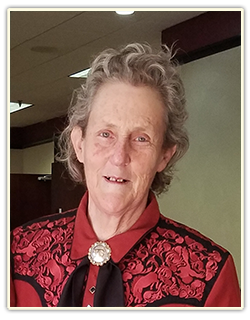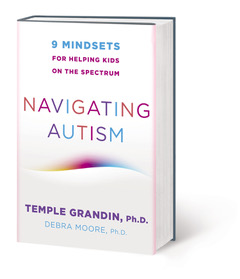
Webinars & Conferences
Upcoming Conferences
April 17 & 18 - ChampionsGate, FL
April 22 - Randolph, MA
April 24 - Oklahoma City, OK
April 25 - Duncan, OK
April 29 - Springfield, MO
May 21 - Ralston, NE
May 28 - Boise, ID
May 30 - Nashville, TN
June 17 - Connecticut
September 19 - Cincinnati, OH
A MUST LISTEN!!
Temple's Latest Books!
Temple Grandin earns Dole Leadership Prize!
NAVIGATING AUTISM
"The Outdoor Scientist"
Using Teachable Moments to Learn
Manners, Social Skills, and Language
I was brought up in the 1950’s and my mother and all the other mothers in the neighborhood used “teachable moments” to teach children correct behavior. When a social or manners mistake was made, Mother NEVER screamed “No” or “Stop it.” Instead, she calmly gave me the instruction of what I should do. Below are some examples.
- If I twirled my fork around above my head, she said, “Put it on your plate.”
- If I ate mashed potatoes with my fingers, she said, “Use the fork.”
- If I touched merchandise in a store, she said, “Only touch the things you are going to buy.”
- If I forgot to say “thank you” she would give me a cue and say, “You forgot to say pause.”
In a day there are many “teachable moments.” At a hotel, I observed an excellent example of this. A little boy started to get on the elevator before the people in the elevator got off. His mom said, “You must wait for the other people to get out of the elevator before you get on.” She did not scream “No” when the child stepped forward towards the open elevator door. Instead, she calmly gave the instruction.
Wait for the Child to Respond
Teachable moments can also be used to encourage use of language. When a child has attained the ability to use a lot of words, he/she needs to be encouraged to use them. If the child wants juice, say “use your words.” WAIT FOR THE CHILD TO RESPOND. An autistic child’s brain processes information more slowly and he/she MUST BE GIVEN TIME TO RESPOND. The most common mistake that both parents and teachers make is to say the word before the child says it. There is a bad tendency to say the word too quickly. Give the child’s brain time to process the request. The processing speed of his/her brain may be like a computer with a slow internet connection. It takes longer for he/she to respond.
In kindergarten when I was age five, I remember an extremely frustrating moment where I was not given sufficient time to respond. The class assignment was to mark pictures when an object’s name began with B. I marked the suitcase picture as B for bag. The teacher marked it wrong and spoke so quickly that I could not explain that in our house suitcases were called bags. I could not respond quickly enough to tell her. If she had waited 2 or 3 seconds, I could have explained that I understood the B concept and explain why I marked certain pictures with a B.
About Temple Grandin
Dr. Grandin did not talk until she was three and a half years old. She was fortunate to get early speech therapy. Her teachers also taught her how to wait and take turns when playing board games. She was mainstreamed into a normal kindergarten at age five. Oliver Sacks wrote in the forward of Thinking in Pictures that her first book Emergence: Labeled Autistic was “unprecedented because there had never before been an inside narrative of autism.” Dr. Sacks profiled Dr. Grandin in his best selling book Anthropologist on Mars.
Dr. Grandin became a prominent author and speaker on both autism and animal behavior. Today she is a professor of Animal Science at Colorado State University. She also has a successful career consulting on both livestock handling equipment design and animal welfare. She has been featured on NPR (National Public Radio) and a BBC Special – "The Woman Who Thinks Like a Cow". She has also appeared on National TV shows such as Larry King Live, 20/20, Sixty Minutes, Fox and Friends, and she has a 2010 TED talk. Articles about Dr. Grandin have appeared in Time Magazine, New York Times, Discover Magazine, Forbes and USA Today. HBO made an Emmy Award winning movie about her life and she was inducted into the American Academy of Arts and Sciences in 2016.
When she was young, she was considered weird and teased and bullied in high school. The only place she had friends was activities where there was a shared interest such as horses, electronics, or model rockets. Mr. Carlock, her science teacher, was an important mentor who encouraged her interest in science. When she had a new goal of becoming a scientist, she had a reason for studying. Today half the cattle in the United States are handled in facilities she has designed.





